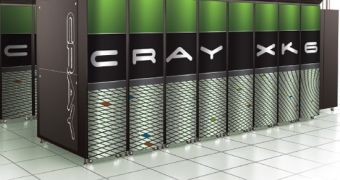Supercomputer maker Cray has recently announced that it has signed a contract to upgrade the Cray XT5 machine nicknamed "Jaguar" located at the Department of Energy's Oak Ridge National Laboratory (ORNL) to a new XK6 HPC system, capable of delivering 20 petaflops of performance.
This new supercomputer will be called Titan and, as we reported a few days ago, it will pack AMD Interlagos processors based on the Bulldozer architecture, as well as Nvidia Tesla graphic processing units.
The first phase of the contract will include replacing the Cray XT5 compute blades with Cray XK6 compute blades, which will feature the upcoming AMD Opteron 6200-series CPUs.
These processors can include up to 16 computing cores and will be paired together with Cray's Gemini interconnect, and a subset of Cray XK6 nodes equipped with NVIDIA Tesla 20-series GPUs.
This first phase is expected to be finalized until the end of this year, while the second phase, which revolves around equipping the system with Tesla GPUs based on the Kepler architecture, is expected to be completed in the second half of 2012.
The contract will bring $97 million into the pockets of Cray, which is roughly equal to 71 million Euros.
"ORNL and Cray have been working together to optimize the Cray XK6 hardware and software architecture for several years. The result of this collaboration is a system specifically developed for scientific applications," said Jeff Nichols, associate laboratory director for Computing and Computational Sciences at Oak Ridge National Laboratory.
"In addition to efficiency and speed, the Cray programming environment allows researchers to continue using Fortran, C, and C++ languages to program the new accelerators."
According to Cray, shipments of Interlagos processors starter later than originally anticipated, but the company is now receiving these chips from AMD. Thanks to its scalable design, the Cray XK6 supercomputer can provide more than 50 petaflops of performance.

 14 DAY TRIAL //
14 DAY TRIAL //